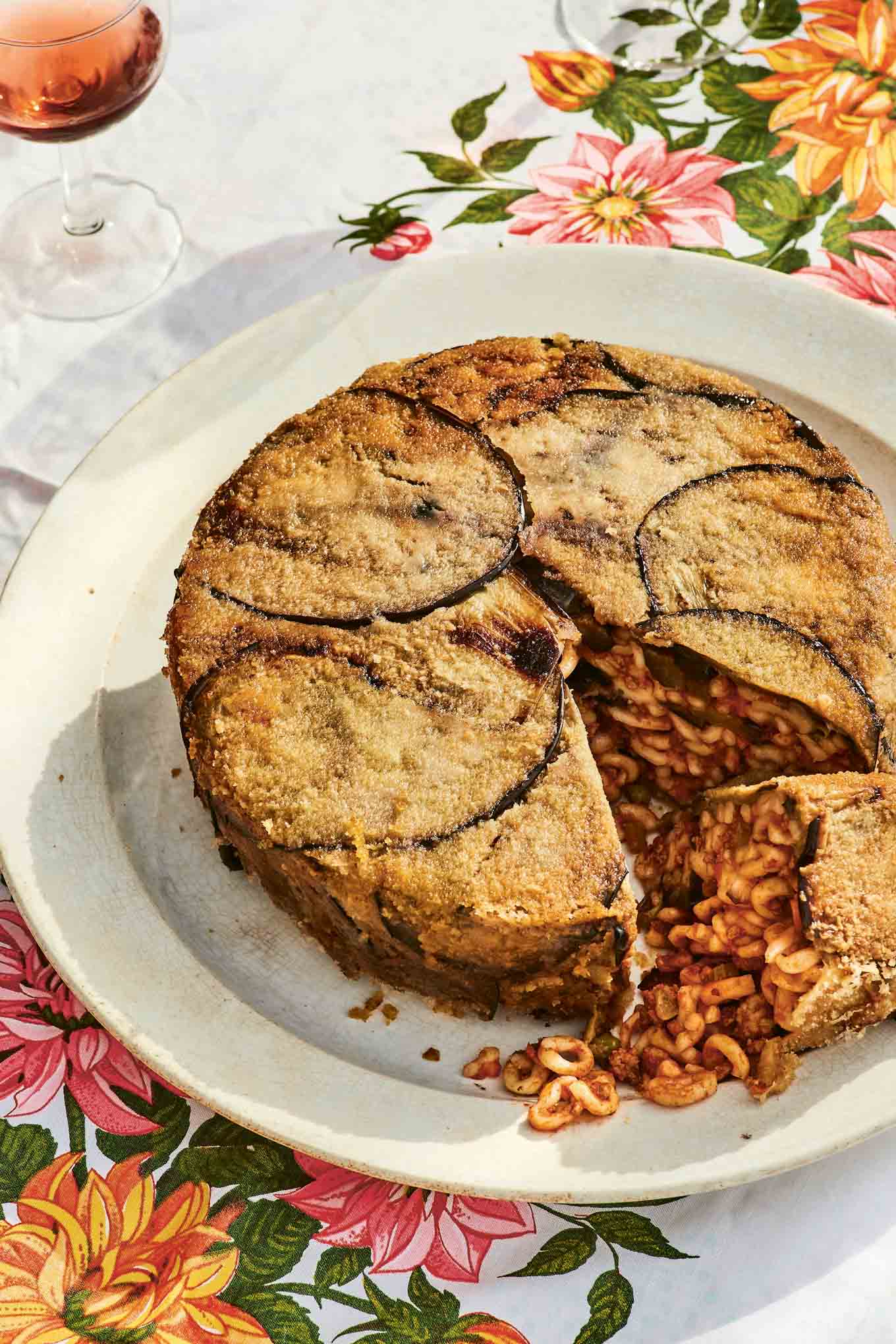
Words by Vicki Bennison Photography by Lizzie Mayson, Vicky Bennison, Emma Lee.
Farmer Emmanuela breeds pedigree cows, produces a dried pasta range using heritage durum wheat, and runs an agriturismo called Masseria Acque di Palermo. ‘You must film my mother’s timballo!’ she declared, when she found out about Pasta Grannies. Her mother, Adi, was way too gracious a host to be startled by a film crew appearing on her doorstep the next morning to shoot Palermo’s classic Sunday-lunch dish. Tiny hooped pasta (anelletti) is essential; if you are keen you can make them, otherwise buy them like most cooks do.
Check out a video of Ada making it here. You can order your copy of Pasta Grannies and Pasta Grannies Comfort Cooking.
Adi’s Anelletti al Forno alla Palermitana: Baked Pasta from Palermo
Ingredients
- 4 tablespoons olive oil
- 1 onion, finely diced
- 2 carrots, 1 finely diced, 1 whole
- 2 celery sticks, finely diced
- 1 tablespoon tomato concentrate
- 300 g 10 1/2oz each of ground pork and beef
- 3 cloves garlic
- 1 kg passata
- 150 g green peas
- salt
- pepper
- 2 or 3 eggplants
- oil for frying, try peanut oil
- butter, for greasing the pan
- 50 g fine dry breadcrumbs
- 200 g grated caciocavallo or provolone cheese
- 200 g primo sale cheese, cubed (fresh, not-too-salty feta is a good substitute)
- 500 g boxed anelletti pasta
Instructions
- To make the ragù, heat the 4 tablespoons of olive oil in a large sauté pan, add the finely diced onion, carrot and celery and fry gently for 10 minutes until soft but not coloured.
- Stir through the tomato concentrate, season with a teaspoon of salt, then add the meat and keep stirring until the latter is no longer pink.
- Punch the 3 cloves into the second carrot and add this along with the passata, then simmer everything for a good 45 minutes until the meat is fully cooked and there’s a nice oily surface to the sauce. Remove the clove-carrot. Stir in the peas and continue to cook for 2–3 minutes until the peas are soft but not mushy.
- Preheat the oven to 180°C (350°F/gas 4).
- Half-cook the fresh or shop-bought anelletti (they continue cooking in the oven and you don’t want mushy pasta), then drain well and put to one side while you prep the aubergines.
- You may need all three, depending on how big they are to begin with. Pour enough oil into a non-stick sauté pan to cover the base. Heat the oil over a medium-high heat until the oil starts to shimmer.
- Cut one aubergine into 2 cm (¾ in) cubes and season with fine salt. Fry the cubes for about 5 minutes, in batches if necessary – you want them to fry, not stew. They are ready when they have started to turn brown and have gone a bit soft.
- Slice the other aubergine lengthways, making slipper shapes about 1 cm (1/2 in) thick. Season the slices with salt and fry them in more oil; they are cooked when they bend easily.
- Grease the inside of a 23 x 8 cm (9 x 3 in) deep springform cake tin with butter, then sprinkle it generously with breadcrumbs.
- Arrange the aubergine slices to cover the bottom and sides, making sure they overlap a bit. Keep three slices for the top.
- Mix the cooked pasta with the ragù; you may not need all the ragù, but make sure the pasta is heavily dressed as it will absorb more liquid during baking. Stir through the grated cheeses, the cubed cheese and the cooked aubergine cubes. Taste and adjust seasoning, then pour the pasta mixture into the tin.
- Next, you need to create an aubergine case by laying more aubergine slices across the top of the pasta, then folding over the side slices. Don’t leave any gaps. Brush the top with some oil or melted butter and sprinkle some more breadcrumbs over the top.
- Bake the timballo in the oven for about 50 minutes; be prepared to let it cook a little bit longer if it’s not golden brown enough.
- Remove it from the oven and let it cool for 20 minutes at room temperature before removing the timballo from its tin.
Pasta Grannies: Comfort Cooking by Vicki Bennison (Hardie Grant, £22), Photography © Lizzie Mayson, Vicky Bennison, Emma Lee